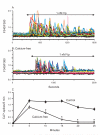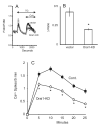Calcium influx mechanisms underlying calcium oscillations in rat hepatocytes
- PMID: 18802964
- PMCID: PMC2808042
- DOI: 10.1002/hep.22461
Calcium influx mechanisms underlying calcium oscillations in rat hepatocytes
Abstract
The process of capacitative or store-operated Ca(2+) entry has been extensively investigated, and recently two major molecular players in this process have been described. Stromal interacting molecule (STIM) 1 acts as a sensor for the level of Ca(2+) stored in the endoplasmic reticulum, and Orai proteins constitute pore-forming subunits of the store-operated channels. Store-operated Ca(2+) entry is readily demonstrated with protocols that provide extensive Ca(2+) store depletion; however, the role of store-operated entry with modest and more physiological cell stimuli is less certain. Recent studies have addressed this question in cell lines; however, the role of store-operated entry during physiological activation of primary cells has not been extensively investigated, and there is little or no information on the roles of STIM and Orai proteins in primary cells. Also, the nature of the Ca(2+) influx mechanism with hormone activation of hepatocytes is controversial. Hepatocytes respond to physiological levels of glycogenolytic hormones with well-characterized intracellular Ca(2+) oscillations. In the current study, we have used both pharmacological tools and RNA interference (RNAi)-based techniques to investigate the role of store-operated channels in the maintenance of hormone-induced Ca(2+) oscillations in rat hepatocytes. Pharmacological inhibitors of store-operated channels blocked thapsigargin-induced Ca(2+) entry but only partially reduced the frequency of Ca(2+) oscillations. Similarly, RNAi knockdown of STIM1 or Orai1 substantially reduced thapsigargin-induced calcium entry, and more modestly diminished the frequency of vasopressin-induced oscillations.
Conclusion: Our findings establish that store-operated Ca(2+) entry plays a role in the maintenance of agonist-induced oscillations in primary rat hepatocytes but indicate that other agonist-induced entry mechanisms must be involved to a significant extent.
Figures








Similar articles
-
Differential roles for STIM1 and STIM2 in store-operated calcium entry in rat neurons.PLoS One. 2011 Apr 26;6(4):e19285. doi: 10.1371/journal.pone.0019285. PLoS One. 2011. PMID: 21541286 Free PMC article.
-
Role of the store-operated calcium entry proteins Stim1 and Orai1 in muscarinic cholinergic receptor-stimulated calcium oscillations in human embryonic kidney cells.J Physiol. 2007 Mar 15;579(Pt 3):679-89. doi: 10.1113/jphysiol.2006.125641. Epub 2007 Jan 11. J Physiol. 2007. PMID: 17218358 Free PMC article.
-
Store-Operated Calcium Entry in Müller Glia Is Controlled by Synergistic Activation of TRPC and Orai Channels.J Neurosci. 2016 Mar 16;36(11):3184-98. doi: 10.1523/JNEUROSCI.4069-15.2016. J Neurosci. 2016. PMID: 26985029 Free PMC article.
-
Store-Independent Orai Channels Regulated by STIM.In: Kozak JA, Putney JW Jr, editors. Calcium Entry Channels in Non-Excitable Cells. Boca Raton (FL): CRC Press/Taylor & Francis; 2018. Chapter 11. In: Kozak JA, Putney JW Jr, editors. Calcium Entry Channels in Non-Excitable Cells. Boca Raton (FL): CRC Press/Taylor & Francis; 2018. Chapter 11. PMID: 30299650 Free Books & Documents. Review.
-
STIMulating store-operated Ca(2+) entry.Nat Cell Biol. 2009 Jun;11(6):669-77. doi: 10.1038/ncb0609-669. Nat Cell Biol. 2009. PMID: 19488056 Free PMC article. Review.
Cited by
-
Gypenosides induce apoptosis by ca2+ overload mediated by endoplasmic-reticulum and store-operated ca2+ channels in human hepatoma cells.Cancer Biother Radiopharm. 2013 May;28(4):320-6. doi: 10.1089/cbr.2012.1327. Cancer Biother Radiopharm. 2013. PMID: 25310348 Free PMC article.
-
Store-Operated Ca2+ Channels in Mesangial Cells Inhibit Matrix Protein Expression.J Am Soc Nephrol. 2015 Nov;26(11):2691-702. doi: 10.1681/ASN.2014090853. Epub 2015 Mar 18. J Am Soc Nephrol. 2015. PMID: 25788524 Free PMC article.
-
Hepatitis B virus modulates store-operated calcium entry to enhance viral replication in primary hepatocytes.PLoS One. 2017 Feb 2;12(2):e0168328. doi: 10.1371/journal.pone.0168328. eCollection 2017. PLoS One. 2017. PMID: 28151934 Free PMC article.
-
TRPC1, STIM1, and ORAI influence signal-regulated intracellular and endoplasmic reticulum calcium dynamics in human myometrial cells.Biol Reprod. 2011 Aug;85(2):315-26. doi: 10.1095/biolreprod.111.091082. Epub 2011 May 12. Biol Reprod. 2011. PMID: 21565997 Free PMC article.
-
Regulation of neurogenesis by calcium signaling.Cell Calcium. 2016 Mar;59(2-3):124-34. doi: 10.1016/j.ceca.2016.02.011. Epub 2016 Mar 15. Cell Calcium. 2016. PMID: 27020657 Free PMC article. Review.
References
-
- Woods NM, Cuthbertson KS, Cobbold PH. Repetitive transient rises in cytoplasmic free calcium in hormone-stimulated hepatocytes. Nature. 1986;319:600–602. - PubMed
-
- Rooney TA, Sass EJ, Thomas AP. Characterization of cytosolic calcium oscillations induced by phenylephrine and vasopressin in single fura-2-loaded hepatocytes. J Biol Chem. 1989;264:17131–17141. - PubMed
-
- Robb-Gaspers LD, Thomas AP. Coordination of Ca2+ signaling by intercellular propagation of Ca2+ waves in the intact liver. J Biol Chem. 1995;270:8102–8107. - PubMed
-
- Putney JW. A model for receptor-regulated calcium entry. Cell Calcium. 1986;7:1–12. - PubMed
Publication types
MeSH terms
Substances
Grants and funding
LinkOut - more resources
Full Text Sources
Miscellaneous
